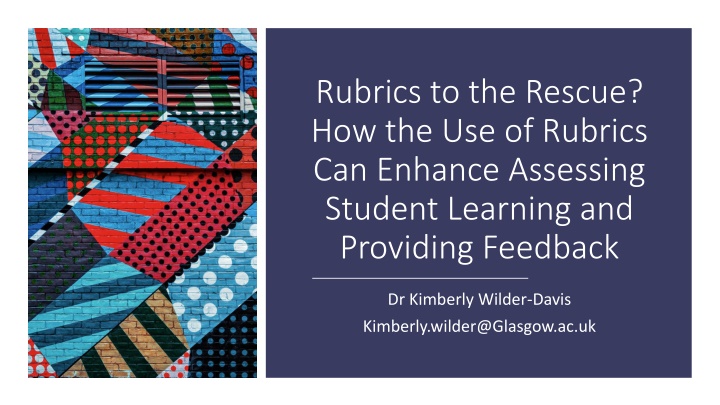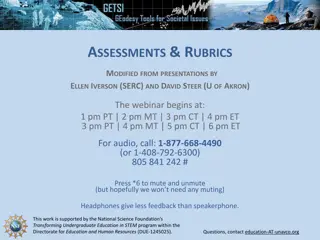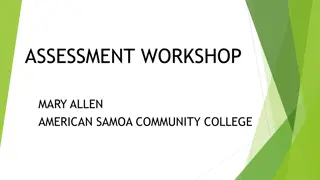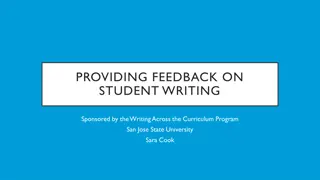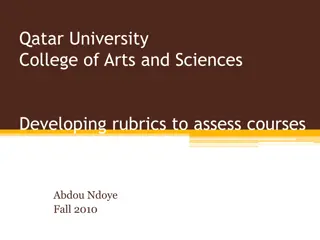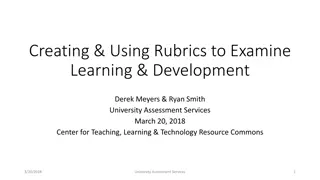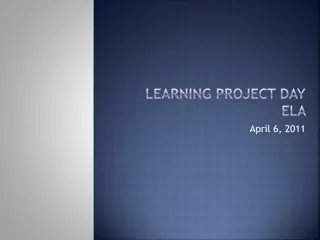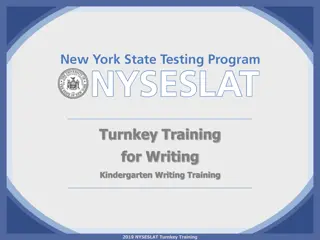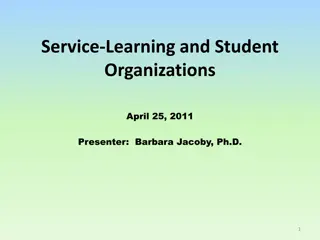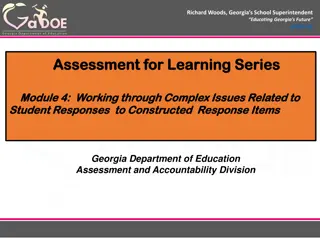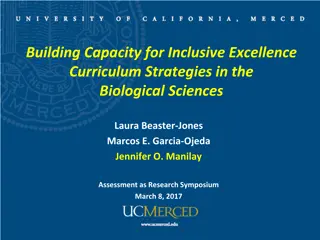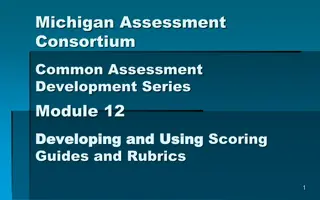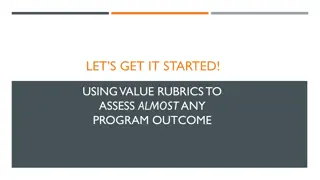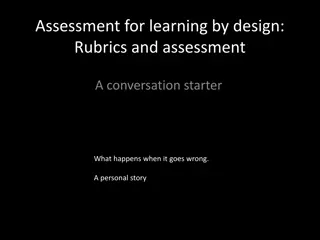Enhancing Assessing Student Learning with Rubrics
Discover how using rubrics can enhance assessing student learning and providing feedback. Explore the benefits and drawbacks of rubrics, types of performances that can be assessed, and tips for creating effective rubrics.
Download Presentation

Please find below an Image/Link to download the presentation.
The content on the website is provided AS IS for your information and personal use only. It may not be sold, licensed, or shared on other websites without obtaining consent from the author.If you encounter any issues during the download, it is possible that the publisher has removed the file from their server.
You are allowed to download the files provided on this website for personal or commercial use, subject to the condition that they are used lawfully. All files are the property of their respective owners.
The content on the website is provided AS IS for your information and personal use only. It may not be sold, licensed, or shared on other websites without obtaining consent from the author.
E N D
Presentation Transcript
Rubrics to the Rescue? How the Use of Rubrics Can Enhance Assessing Student Learning and Providing Feedback Dr Kimberly Wilder-Davis Kimberly.wilder@Glasgow.ac.uk
Why Should You Consider a Rubric? What is your current view of rubrics? Share your thoughts on the pros and cons of rubrics
Why Should You Consider a Rubric? What is the purpose of a rubric? Consider this definition: A rubric is a coherent set of criteria for students' work that includes descriptions of levels of performance quality on the criteria. How does a rubric help our students with their learning?
Types of Performances That Can Be Assessed With Rubrics Type of Performance Examples Processes Physical skills Use of equipment Oral communication Work habits Playing a musical instrument Doing a forward roll Preparing a slide for the microscope Making a speech to the class Reading aloud Conversing in a foreign language Working independently How to Create and Use Rubrics for Formative Assessment and Grading by Susan M. Brookhart Products Constructed objects Written essays, themes, reports, term papers Other academic products that demonstrate understanding of concepts Term paper on theatrical conventions in Shakespeare's day Written analysis of the effects of the Marshall Plan Model or diagram of a structure (atom, flower, planetary system, etc.) Concept map
What Type of Rubric Do You Need? Holistic rubric A holistic rubric uses rating scales that include the criteria. For example: Weak Satisfactory Strong Analytic rubric An analytic rubric uses a rating scale to evaluate each criterion separately, forming a grid or table in which the rating scale is presented in the top row and each criterium is listed down the leftmost column. Define the criteria Ask yourself: what knowledge and skills are required for the assignment/assessment? Make a list of these, group and label them, and eliminate any that are not critical. The list should contain no more than 6-7 criteria, but need not include that many. Helpful strategies for defining grading criteria: Review the learning objectives for the course; use the assignment prompt, existing grading checklists, peer response sheets, comments on previous work, past examples of student work, etc. https://www.brown.edu/sheridan/teaching-learning-resources/teaching-resources/course-design/classroom- assessment/grading-criteria/designing-rubrics
Creating Rubrics Made Easy Before you create your rubric, consider the following questions from The Harriet W. Sheridan Center for Teaching and Learning: What exactly is the assigned task? Does it break down into a variety of different tasks? Are these tasks equally important? What are the learning objectives for this assignment/task? What do you want students to demonstrate in their completed assignments/performances? What might an exemplary student product/performance look like? How might you describe an acceptable student product/performance? How might you describe work that falls below expectations? What kind of feedback do you want to give students on their work/performance? Do you want/need to give them a grade? Do you want to give them a single overall grade? Do you want to give them detailed feedback on a variety of criteria? Do you want to give them specific feedback that will help them improve their future work? https://www.brown.edu/sheridan/teaching-learning-resources/teaching-resources/course- design/classroom-assessment/grading-criteria/designing-rubrics
Creating Rubrics Made Easy Analytic Rubric Determine the various skills and abilities that students should demonstrate to show achievement of the learning outcome(s). These skills and abilities are the various criteria. Each criterion should focus on a different skill identified by a phrase or brief statement, and each criterion should be measureable through the examination of student work. The criteria become the leftmost column of the grid. o The next step is to determine the levels of achievement possible given the expectations of what students are to be able to demonstrate. The levels can be numerical categories but more frequently are descriptions. Common examples of achievement levels include: o Short Descriptions: o Unacceptable...Marginal...Proficient...Distinguished o Beginning...Developing...Competent...Exemplary o Improvement...Satisfactory...Good...Accomplished o Poor...Minimal...Sufficient...Above Average...Excellent https://resources.depaul.edu/teaching-commons/teaching-guides/feedback- grading/rubrics/Pages/creating-rubrics.aspx
Creating Rubrics Made Easy Holistic Rubrics When using a holistic rubric the assessor judges the level of performance across. In general holistic rubrics are considered faster to create and implement, however, they do not facilitate analysis and feedback in the same way as analytical rubrics. Determine all the skills and abilities students need to demonstrate in order to achieve the learning outcome. Clarity, organization, and grammar. Determine the appropriate levels of accomplishment. Needs improvement, developing, sufficient, and above average. Write an overall description of how a student would demonstrate the learning outcome for each level of accomplishment. When creating a holistic rubric this step cannot be skipped. https://resources.depaul.edu/teaching-commons/teaching-guides/feedback- grading/rubrics/Pages/creating-rubrics.aspx
Assessment is governed by the University s Code of Assessment, which is part of the University Calendar (the formal regulations). A full explanation is provided here. This specifies a set of grades from A1 (highest) to H (lowest) The 22 point scale should be the basis for consideration when creating your rubric The 22 Point Scale
Rubrics=Support for Meaningful Assessment Rubrics are a great tool for teaching and learning. They: support authentic assessment: While traditional tests measure how well students recall content, rubrics measure how well students can apply knowledge to authentic contexts or real-world tasks. communicate expectations: rubrics define student "quality" in terms of objective criteria and standards, they clearly communicate how instructors will evaluate student performance. improve performance: When students understand assignments and expectations before they begin, they are more likely to fulfil them. They know what specific criteria and standards of excellence will be used to rate their performance. 2006 University of Colorado | The Center for Faculty Development |
Rubrics=Support for Meaningful Assessment provide informative feedback: rubrics define specific elements of a learning task and describe levels of quality, instructors can provide informative feedback to students about where they perform well and where they need improvement. promote thinking and learning: Rubrics promote thinking and higher levels of learning. Used to provide formative feedback, rubrics enable students to systematically review and revise their learning assignments, promoting reflective learning. inspire fairness: Because rubrics have detailed assessment information, students don't feel that grades are assigned subjectively or arbitrarily. Also, when you have more than one grader, a rubric allows all graders to apply the same criteria in the same way. 2006 University of Colorado | The Center for Faculty Development |
Creating Rubrics Made Easy What do you want your students to be able to demonstrate through your assessment or assignment? Start with your assessment criteria, your ILOs and the 22 point scale Keep it simple! You want your students to be able to understand the rubric so they understand how they are being assessed. Students should also see how the ILOs fit with the assessment and how they will be marked. If possible, get student input or elicit their help in creating the rubric Their perspective can be invaluable in the process as they are also the ones that will use the rubrics
